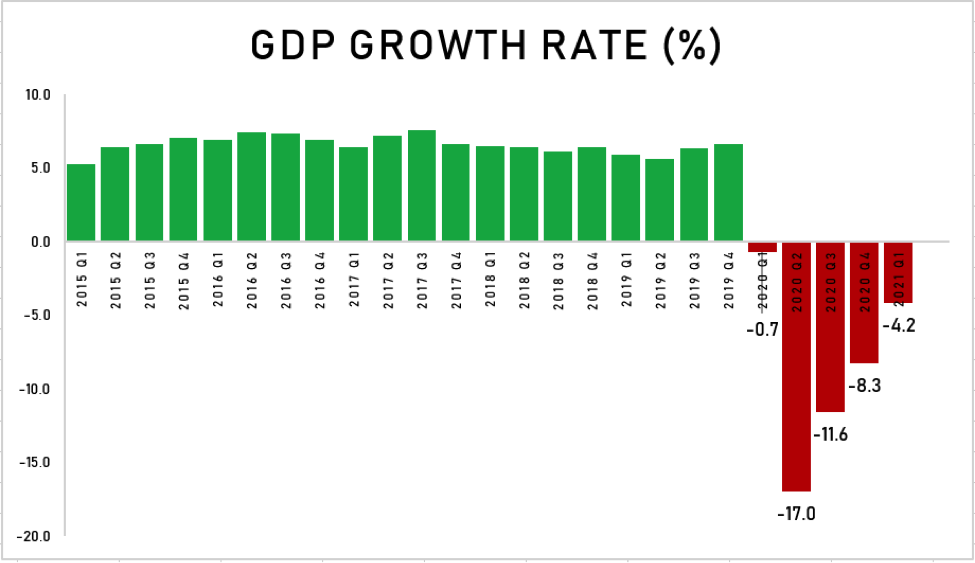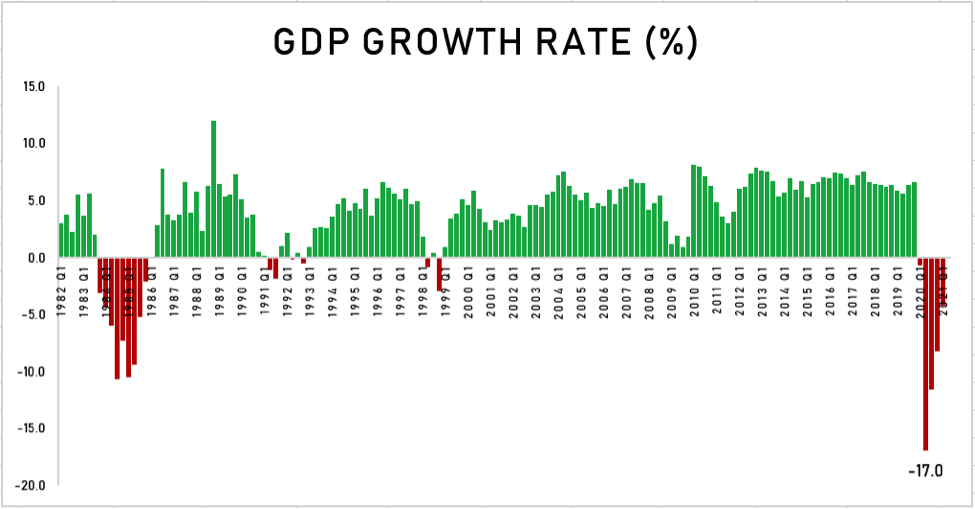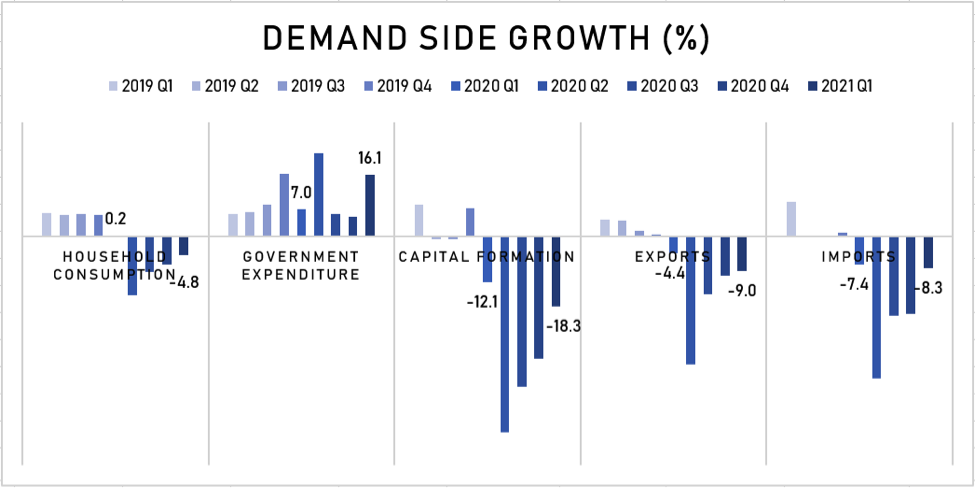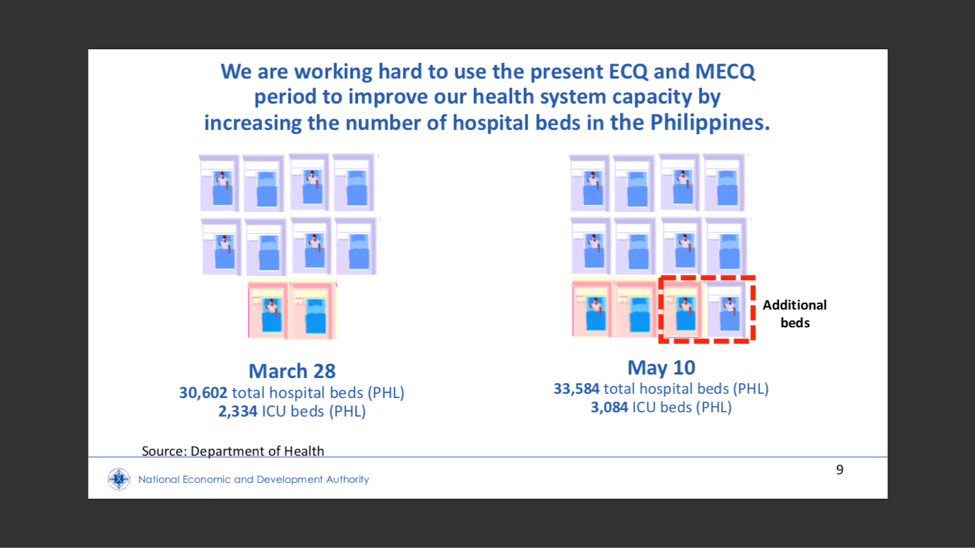Dissecting Data: Economy sheds over P2 trillion in 15 months as quarantines bite | ABS-CBN

Welcome, Kapamilya! We use cookies to improve your browsing experience. Continuing to use this site means you agree to our use of cookies. Tell me more!
Dissecting Data: Economy sheds over P2 trillion in 15 months as quarantines bite
Dissecting Data: Economy sheds over P2 trillion in 15 months as quarantines bite
Warren de Guzman and Edson Guido,
ABS-CBN News
Published May 11, 2021 03:10 PM PHT
The Philippine economy contracted by 4.2 percent in the first quarter of 2021 as the country continued to struggle to bring the COVID-19 outbreak under control. This figure was worse than the -3.2 median forecast in a poll of economists by Bloomberg, and the -3 percent median forecast in another poll by Reuters.
The Philippine economy contracted by 4.2 percent in the first quarter of 2021 as the country continued to struggle to bring the COVID-19 outbreak under control. This figure was worse than the -3.2 median forecast in a poll of economists by Bloomberg, and the -3 percent median forecast in another poll by Reuters.
This was the first time the Philippine economy contracted for 5 consecutive quarters since the debt crisis of the 1980s. The recession then, during the Marcos administration, lasted 9 quarters.
This was the first time the Philippine economy contracted for 5 consecutive quarters since the debt crisis of the 1980s. The recession then, during the Marcos administration, lasted 9 quarters.
What do these 5 straight quarters of economic decline mean in real terms? Over P2 trillion in losses.
What do these 5 straight quarters of economic decline mean in real terms? Over P2 trillion in losses.
Total GDP (at constant 2018 prices in peso)
2019: 19.383 trillion
2020: 17.527 trillion
Total GDP (at constant 2018 prices in peso)
2019: 19.383 trillion
2020: 17.527 trillion
ADVERTISEMENT
Total real value lost (in pesos)
2020: 1.856 trillion
2021 Q1: 186 billion
Total real value lost (in pesos)
2020: 1.856 trillion
2021 Q1: 186 billion
Loss from 2020 Q1 to 2021 Q1: 2.041 trillion
(ABS-CBN Data Analytics, data from PSA)
Loss from 2020 Q1 to 2021 Q1: 2.041 trillion
(ABS-CBN Data Analytics, data from PSA)
The total real value lost in the first quarter amounted to P186 billion. The total real value lost from the first quarter of 2020 to the first quarter of 2021 was P2.041 trillion.
The total real value lost in the first quarter amounted to P186 billion. The total real value lost from the first quarter of 2020 to the first quarter of 2021 was P2.041 trillion.
Based on available data as of May 11, the Philippines was the worst-performing economy among major ASEAN nations.
Based on available data as of May 11, the Philippines was the worst-performing economy among major ASEAN nations.
Household spending, capital formation, exports, and imports all contracted on the demand side. Government spending expanded at its fastest pace in three quarters, rising 16.1 percent, but it was not enough to offset the other losses.
Household spending, capital formation, exports, and imports all contracted on the demand side. Government spending expanded at its fastest pace in three quarters, rising 16.1 percent, but it was not enough to offset the other losses.
Agriculture contracted for a second consecutive quarter. This was blamed on the African swine fever outbreak.
Agriculture contracted for a second consecutive quarter. This was blamed on the African swine fever outbreak.
Services contracted for a fourth straight quarter. Industry contracted for a fifth straight quarter.
Services contracted for a fourth straight quarter. Industry contracted for a fifth straight quarter.
Socioeconomic Planning Secretary Karl Chua said this losing streak won’t last as long because the 2021 COVID-19 spike is already easing.
Socioeconomic Planning Secretary Karl Chua said this losing streak won’t last as long because the 2021 COVID-19 spike is already easing.
“At the peak of this spike, NCR cases were above 5,000. The latest data show NCR cases have gone down by 60 percent or to 2,000,” Chua said.
“At the peak of this spike, NCR cases were above 5,000. The latest data show NCR cases have gone down by 60 percent or to 2,000,” Chua said.
He added that the looser modified enhanced community quarantine was imposed last August when the country hit a high of 4,000 cases per day. When this number further went down to 2,000 cases per day, restrictions were further eased to general community quarantine.
He added that the looser modified enhanced community quarantine was imposed last August when the country hit a high of 4,000 cases per day. When this number further went down to 2,000 cases per day, restrictions were further eased to general community quarantine.
“So these are some indications that there is some opening to relax to quarantine. But this is subject to IATF resolution when we do the cost-benefit analysis,” Chua added.
“So these are some indications that there is some opening to relax to quarantine. But this is subject to IATF resolution when we do the cost-benefit analysis,” Chua added.
Chua also noted that the ECQ and MECQ imposed this year allowed for more movement and economic activity, while the same lockdowns imposed in 2020 effectively shut down 75 percent of the economy.
Chua also noted that the ECQ and MECQ imposed this year allowed for more movement and economic activity, while the same lockdowns imposed in 2020 effectively shut down 75 percent of the economy.
Chua however noted that ultimately the COVID-19 pandemic is a health crisis, and must be addressed as so. He said improvements have been made, such as the increase of intensive care unit bed capacity in hospitals.
Chua however noted that ultimately the COVID-19 pandemic is a health crisis, and must be addressed as so. He said improvements have been made, such as the increase of intensive care unit bed capacity in hospitals.
However he said more needs to be done. “Our contact tracing is not as fast as we want it,” Chua said. Based on epidemiological models, Chua said faster contract tracing would greatly reduce new cases, and facilitate a quicker return to lighter quarantine conditions.
However he said more needs to be done. “Our contact tracing is not as fast as we want it,” Chua said. Based on epidemiological models, Chua said faster contract tracing would greatly reduce new cases, and facilitate a quicker return to lighter quarantine conditions.
For now the government said it will stick to its 6.5 to 7.5 percent GDP growth forecast range for 2021.
For now the government said it will stick to its 6.5 to 7.5 percent GDP growth forecast range for 2021.
Economic growth will probably be closer to 4 percent this year, said Steve Cochrane, chief Asia-Pacific economist at Moody's Analytics.
Economic growth will probably be closer to 4 percent this year, said Steve Cochrane, chief Asia-Pacific economist at Moody's Analytics.
The Asian Development Bank meanwhile forecasts growth of at least 4.5 percent this year and 5.5 percent in 2022.
The Asian Development Bank meanwhile forecasts growth of at least 4.5 percent this year and 5.5 percent in 2022.
The International Monetary Fund said growth of up to 6.9 percent was possible but warned of downside risks due to uncertainties brought by the pandemic.
The International Monetary Fund said growth of up to 6.9 percent was possible but warned of downside risks due to uncertainties brought by the pandemic.
ADVERTISEMENT
ADVERTISEMENT










